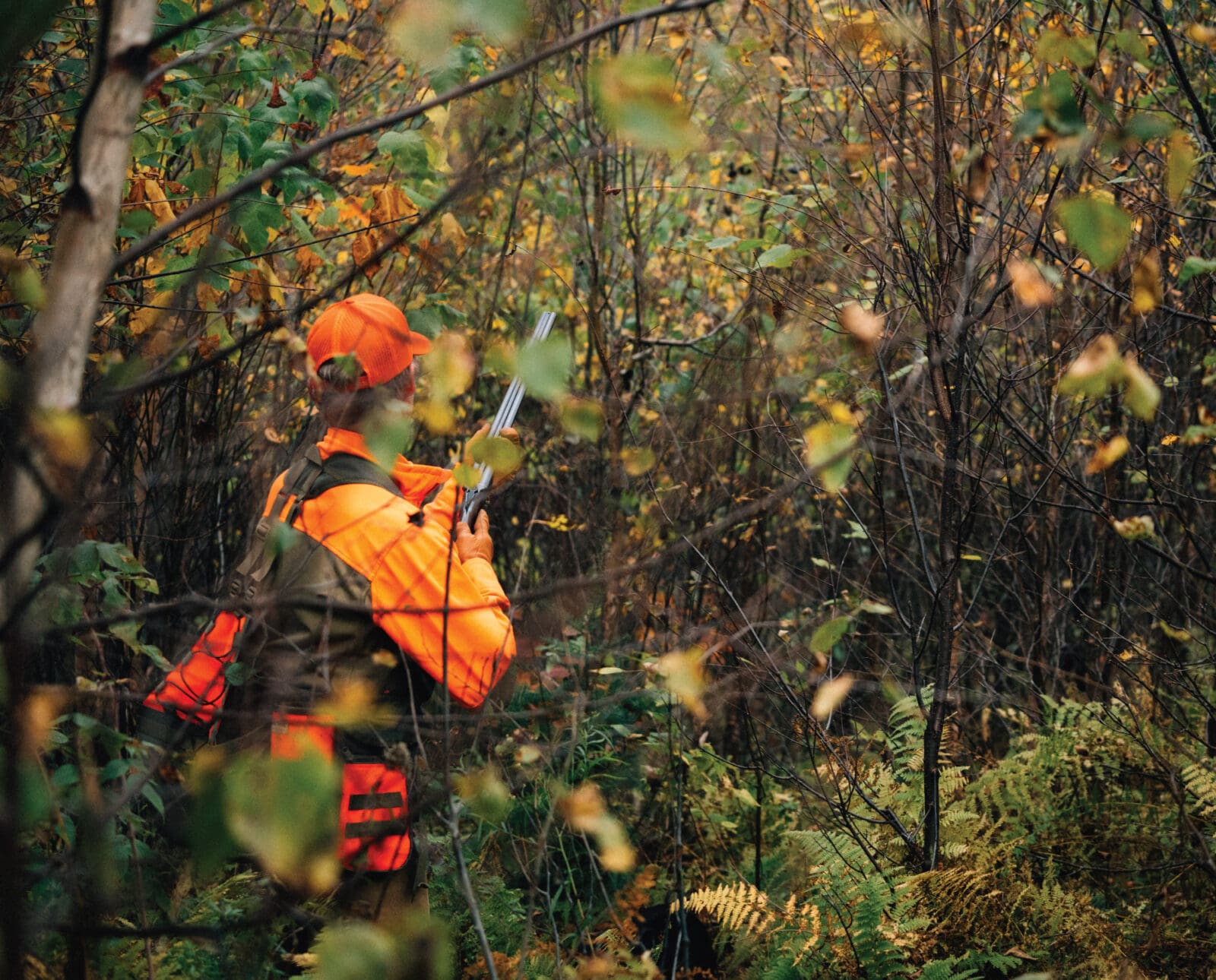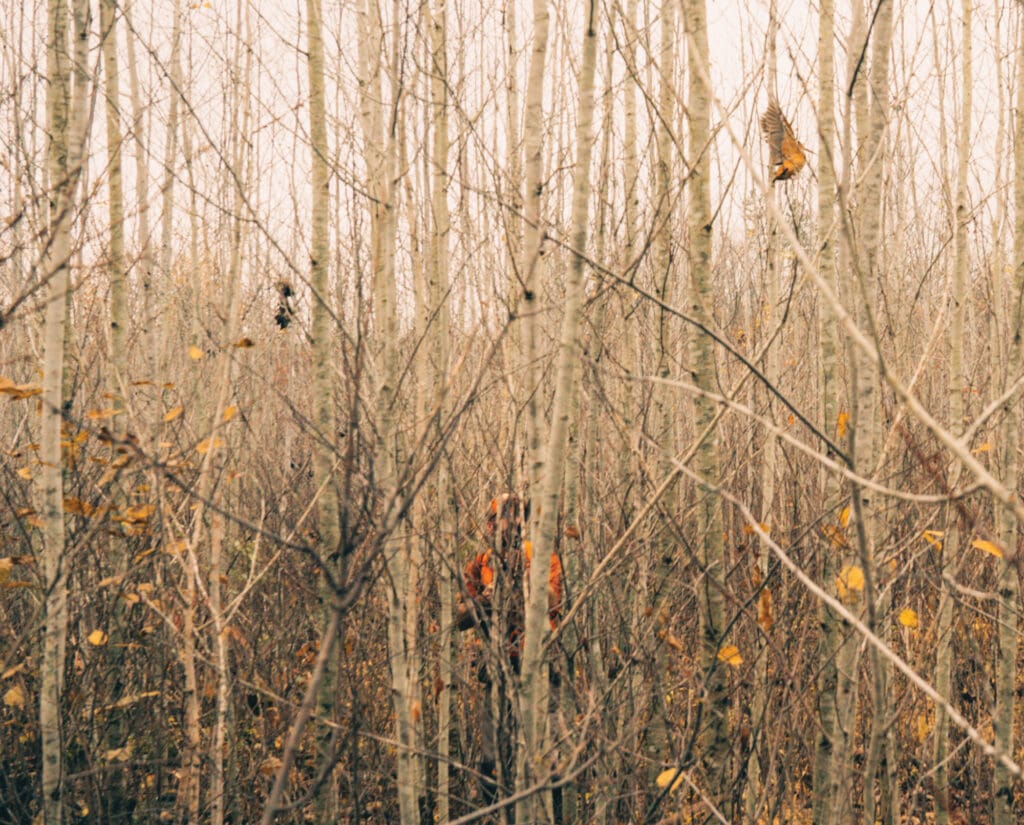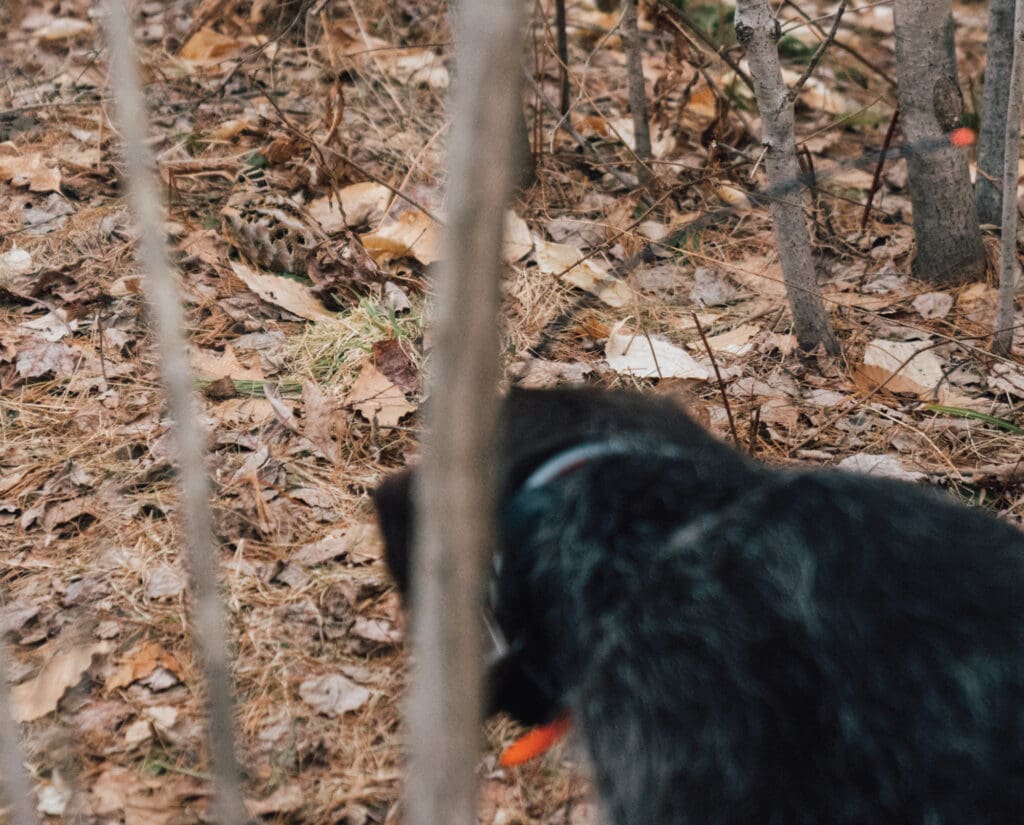Home » Woodcock Hunting » Tips for Better Woodcock Shooting Skills
Tips for Better Woodcock Shooting Skills

A.J. DeRosa, founder of Project Upland, is a New England…
Dive into seasoned tips for mastering woodcock shooting skills. From understanding their unique flight patterns to perfecting your gun mount, enhance your wingshooting techniques for this elusive bird.
“Woodcock are neither the hardest nor the easiest bird to shoot.” I am not sure I can sum up woodcock shooting better than those words of George Bird Evans, author of Upland Shooting Life. Over 35 years have passed since I shot my first woodcock, and I have learned from others and my own errors how to get better or at least improve my woodcock shooting skills.
Listen to more articles on Apple | Google | Spotify | Audible
While the American woodcock can fly upwards of 30 mph through impossibly thick cover, they are also capable of some of the slowest flights recorded of a bird. Woodcock are an unusual bird to wingshoot; their erratic and unpredictable flight patterns have coined them the nickname mudbats. There will be moments where they seem to float to the canopy with their head turned, those big eyes looking back at you, almost convincing you to reach out and try to catch it with your hands. You may ask yourself, “How could I miss that shot?”
There are other moments when they stay true to nicknames like the “timber rocket” as they launch at speeds that resemble the most difficult ruffed grouse shooting skills. I think the inconsistency of flush patterns is where wingshooters struggle most. It is hard to develop muscle memory when they present two ends of an extreme. Ruffed grouse and woodcock are often hunted simultaneously, and one can have trouble shifting gears between different styles of wingshots.
George Bird Evans believed the average for good shooting on woodcock was two shells for every one bird. They are not difficult birds to kill. A single pellet is enough to put a woodcock on the dinner table. Here, we explore some theories and ideas to help improve your woodcock shooting skills this season.
Gun Mount Matters the Most for Woodcock Shooting
For centuries, famous woodcock hunting authors have pointed out one consistency: gun mount is the most important part of woodcock shooting. Perfecting the gun mount is something that can be practiced in your home. With an unloaded shotgun, pick something off in the distance and mount your shotgun. Was the shotgun properly aligned as soon as it hit your shoulder? If not, readjust your grip and try again. The goal is to make this perfect mount part of your muscle memory. Do this a few times a day as the season comes, and remember to keep both eyes open.
Gun mount and gun fit go hand in hand. If you do not own a gun that was properly fit to your body, at a minimum, use the same gun and stick to it. Changing shotguns will affect the muscle memory you are trying to build on gun mount.
Proper Shot Size, Chokes, and Gauges for Woodcock
Take a room full of woodcock hunters and ask them what shot size you should use. You may see them descend into a feverish debate. Some woodcock hunters, or should I say grouse hunters who also hunt woodcock, will live by larger shot size like No. 7 ½. Strictly woodcock hunters will argue for as small as No. 9 or even No. 10 shot.
There are some key points to consider when choosing shot size to hunt woodcock. The biggest challenge is not destroying such a small, delicate bird for the dinner table. Therefore, low-pressure loads are your friend.
- Are you hunting ruffed grouse as well? If so, use No. 8 lead shot. In most cases, it is large enough to kill a ruffed grouse and still small enough not to damage a woodcock.
- Are you only hunting woodcock? Go for No. 9 lead shot, reducing the risk of damage to the bird while still breaking through small branches and leaves.
- Are you using non-toxic shot? No. 7 steel shot is not impossible to find, but shooting woodcock at close range with such hard shot with a tight pattern can be destructive. Let the birds get out there so your shot pattern can expand. Finding No. 8 in bismuth shot is possible, which is an ideal option for non-toxic woodcock loads.
When thinking about what type of shot to use, strongly consider using non-toxic shot. Worms, a woodcock’s primary food source, absorb heavy metals, including lead. Recent peer-reviewed studies depict high densities of man-made lead in woodcock blood on traditional hunting grounds where lead shot is used because they eat lead-filled worms. While we can be grateful that woodcock can survive such high toxicities, waterfowl research has shown those same levels are fatal to ducks. There are also credible concerns about the human consumption of woodcock with such high lead concentrations. I understand that vintage shotgun owners are concerned about barrel damage issues; however, everyone else has no valid excuse for shooting lead at woodcock outside cost.
When it comes to shotgun chokes, wide open is your friend. On my current grouse gun, I shoot skeet and skeet chokes. Referencing my earlier comment on damaging the bird’s meat, I would not suggest using anything over an improved cylinder. Let the bird get out before shooting if no open option is available.
Spreader loads are something of a woodcock hunter’s invention. These specially loaded shotgun shells allow pellets to spread faster than traditional loads as woodcock shooting can be very close range. But these loads can be difficult to find.
Any shotgun gauge will work for a woodcock. While I am a 28-gauge fanatic, any gauge is suitable. Low-pressure loads in larger gauges like 12 and 16-gauge should be absolute. The .410, while I have killed woodcock with it, is just a horribly patterning gauge. This makes it inferior to other popular gauge sizes. Your shot pattern really matters when it comes to shooting woodcock.

Ignoring the Trees is the First Rule of Woodcock Shooting
Woodcock cover ranges from thick alders in areas with poor footing to young trees with lots of foliage. If you are looking at those obstacles while shooting and being overly concerned about when to shoot as a result, you will fail. Ignoring the trees is the cornerstone of wingshooting in forested habitats. Like many, I grew up hunting thick cover; ignoring the trees is second nature. Although I do not have any profound advice on how to get over the trees, I know you must ignore them to succeed in woodcock shooting.
Two Schools of Woodcock Shooting
Spend enough time hunting woodcock with other people, and you will see two schools of thought on when to shoot woodcock. Both are grounded in the idea of a slow, intentional mount, accounting for the fundamental nature of how woodcock flush.
How do woodcock flush? Oftentimes, very close. While woodcock in high-pressure areas certainly do walk and run from dog points, for the most part, they hold very tight. In many cases, they will flush only a few feet away. That’s why woodcock is a dog’s best friend.
They also fly slowly depending on surrounding openings. Unlike ruffed grouse, which will plow through everything in its path in a feathery fury, woodcock will dance around every leaf and branch as they head for the canopy.
- The Perfect Mount Method: For lack of a better term, the perfect mount method is simply based on properly mounting your shotgun. Ruffed grouse hunting makes a lot of snapshooters who often shoulder their gun too fast for a good gun mount. Even though it’s bad form for grouse shooters to “snap shoot,” I find it to be a very objective term because taking enough time to mount your shotgun properly can happen fast, especially with practice. In this method, when the gun kisses your shoulder, you pull the trigger wherever that zig-zagging bird has taken you. This is close shooting, so wide-open chokes are a must. I belong to this school of thought.
- The Canopy Method: As you have probably figured out, woodcock can fly very erratically. In the “perfect mount method,” a smooth, well-placed mount is often wasted on a bird that abruptly changes directions. Some folks believe one should let a woodcock level out before shooting. This usually means clearing the canopy or an opening where a woodcock can choose a direction and stick to it. This method takes patience. It can mean less shooting but also less chance of ruining the bird for the dinner table as your target is often further away. Putting distance between you and a very small woodcock also helps your shot spread out, which can increase your hunting success.
Beware of Low Flying Woodcock
This is a public service announcement for the dog’s sake. Woodcock will frequently fly really low to the ground. Avoid shots not well above waist height; close dogs and low shots can spell disaster. In both the pointing dog and spaniel world, most dogs are not steady past the flush. Woodcock, who can tolerate sub-par dog work, means your dog is close to the bird and your shot. Even if your dog is steady, one break could spell disaster. Have the “ethics of hunting over a dog” talk with everyone shooting before you hunt. Talk again after a bird is put into the air. Have it again as many times as necessary for the sake of our four-legged friends.

Approaching the Point and Do Not Look for the Bird
Handle everything like a ruffed grouse contact if you are simultaneously hunting both ruffed grouse and woodcock. This means keeping a good pace and accounting for the fact that the grouse will run ahead of the dog. One should make intentional movements from small opening to small opening where shooting and swinging is possible. I will not get into the weeds on the grouse part of this, but if it is a woodcock, it will most likely hold tight for you, giving you time to return to the dog and work on a proper flush.
You can take your time when it comes to a woodcock point. However, do not look for the bird sitting on the ground. While I am guilty as charged, I carry a camera more days a year than a shotgun. Seeing that bird on the ground is a great way to put yourself at a disadvantage on the shooting part. Tracking the bird from that position and mounting your gun becomes harder. Edmund Davis discusses this in the 1908 classic Woodcock Shooting, “When the dog points, do not try to see the cock on the ground. The sudden changing of the eyes from the ground to the line of flight as the bird rises is confusing and is apt to make one shoot too soon. More woodcock are missed in this way than when the eyes are elevated.”
Sound footing can go a long way in shooting, and woodcock live in nasty places. I will reveal the upland heathen in me; while my dog is steady to release, I hunt alone a lot. Not having someone to flush the woodcock can mean, in many cases, a straight-up impossible shot because of how tight a woodcock can hold. So, release the dog. Yes, I said it. Let the dog flush the bird. The term “stop to flush” is relevant here. A solid dog will move in, and when the bird flushes, stop moving until released. In many European countries, pointing dogs are actually required to flush the bird after a hunter releases them as part of the trialing rules.
When the Shooting is Bad
I often prefer the days when woodcock flights are in, and the shooting is bad. However, like anything, there are times when the wheels come off. The more you miss, the more you get in your own head, and the worse things get. I struggled with this when I was younger, but my solution, unsurprisingly, has to do with gun mount. Take time afield to remount your gun and look at distant items repeatedly. This resets both your muscle memory and your confidence. More often than not, poor gun mount is to blame for poor shooting. This may not always fix these lulls in shooting, but they can at least sometimes.
Woodcock shooting is one of the longest-standing wingshooting traditions in the United States, next to snipe shooting. The cooperation they display for the dogs, combined with shooting that is not too easy but not too hard, makes for wonderful days in the woods. Like anything, practical application will never be replaced. To get better and show progress, get outside and be okay with failing along the way. That is all part of the wonder of hunting.
A.J. DeRosa, founder of Project Upland, is a New England native with over 35 years of hunting experience across three continents. His passion for upland birds and side-by-side shotguns has taken him around the world, uncovering the stories of people and places connected to the uplands. First published in 2004, he wrote The Urban Deer Complex in 2014 and soon discovered a love for filmmaking, which led to the award-winning Project Upland film series. A.J.'s dedication to wildlife drives his advocacy for conservation policy and habitat funding at both federal and state levels. He serves as Vice Chair of the New Hampshire Fish & Game Commission, giving back to his community. You can often find A.J. and his Wirehaired Pointing Griffon, Grim, hunting in the mountains of New England—or wherever the birds lead them.




Here in my area I’d SE Texas “creek branches” leading out of upland areas into larger creek/bayou bottoms are often the preferred locations for birds. “Branch” areas adjacent to pastures or hay meadows often hold birds. Posting a ‘shooter’ along the “branch” edge in the open field while the dog handler ‘busts the brush’, can lead to excellent shooting opportunities as flushed birds will often fly to the tree-line edge and proceed up or down that edge. Their flight at that time is usually straight and level.
Love these pod cast no matter what brand of upland hunting it is. If its one I haven’t tried these pod cast drive me to explore it
Keep them coming